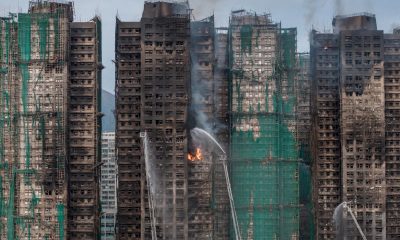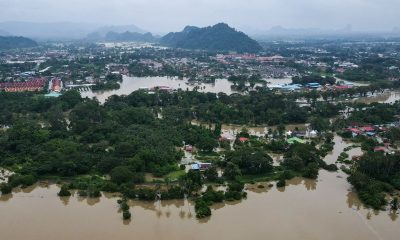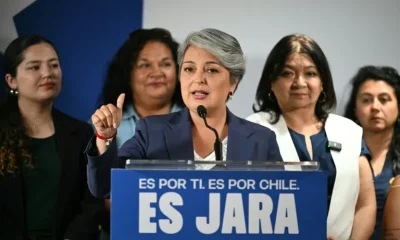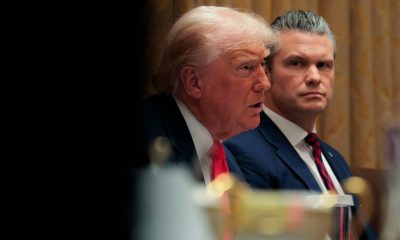International
Retired Colombian soldiers admit to murder of 120 civilians
AFP
Ten retired members of Colombia’s military began admitting to victims’ families on Tuesday their roles in the assassination of 120 civilians that were later presented as rebels killed in combat.
It was the first public admission by the former soldiers that they had made people disappear before killing them in cold blood.
One general, four colonels and five officers, as well as a civilian, were due to make their confessions to the special tribunal set up as part of the 2016 peace deal that ended a half century of conflict between the government and Revolutionary Armed Forces of Colombia (FARC) rebels.
The “false positives” scandal in which murdered civilians were passed off as enemy combattants is the largest ever to have rocked Colombia’s armed forces.
“I ask you to clear our family names … they were rural workers, not subversives, guerrillas and thugs as they were branded,” said Eduvina Becerra, the partner of Jose Ortega, a murdered farmer.
Around 50 of the victims’ family members showed up to the university theater in Ocana, close to Colombia’s northern border with Venezuela, where the Special Jurisdiction for Peace (JEP) hearing took place.
“I acknowledge and accept my responsibility as co-perpetrator” of the murders that took place between 2007 and 2008, said Nestor Gutierrez, a former non-commissioned officer in the army.
“We murdered innocent people, peasants,” said Gutierrez, promising to “clarify it here before the judgment, before the world, before the country.”
In front of an audience of sobbing family members, the soldiers gave details about how they murdered the victims, most of whom were men aged 25 to 35.
The JEP, which was set up in 2017 to try the worst atrocities committed during the conflict, said that Ocana was the site of a sinister plan thought up by a battalion stationed in the town of 100,000 and motivated by “the army’s institutional policy of counting bodies” to inflate the reporting of their successes in combating guerrillas and other armed groups.
The tribunal says more than 6,400 civilians were murdered between 2002 and 2008 after being lured to areas far from their homes.
The JEP has the authority to offer alternatives to jail time to people who confess their crimes and make reparations.
The Catatumbo region where Ocana is located is home to the largest area of illegal coca leaf crops used to make cocaine in the world, making it a hub for organized crime.
The hearing is due to last two days with former general Paulino Coronado the highest ranking officer on trial.
International
El Chapo’s son Joaquín Guzmán López pleads guilty to U.S. drug trafficking charges

Joaquín Guzmán López, one of the sons of notorious Mexican drug lord Joaquín “El Chapo” Guzmán, pleaded guilty on Monday to drug trafficking charges in a U.S. court, months after his brother Ovidio reached a similar plea agreement, according to local media reports.
The defendant appeared before a federal court in Chicago early Monday afternoon and changed his previous plea in the case, the Chicago Tribune reported. U.S. authorities accuse him of forming, together with his three brothers, the cartel faction known as “Los Chapitos.”
The group is believed to have continued the operations of El Chapo, who has been serving a life sentence in the United States since 2019.
Guzmán López, 39, was arrested after landing in Texas in a small aircraft alongside cartel co-founder Ismael “El Mayo” Zambada.
International
Venezuela authorizes return flights as U.S. continues deportations amid rising tensions

The arrival of U.S. aircraft carrying undocumented Venezuelan migrants continued regularly despite rising tensions between Washington and Caracas over President Donald Trump’s military deployment in the Caribbean.
Trump maintains that the deployment is part of an anti-narcotics operation, while Venezuelan President Nicolás Maduro insists the true objective is to remove him from power and seize the nation’s oil resources.
Venezuela’s aviation authority has “received a request from the United States government to resume repatriation flights for Venezuelan migrants from that country to Venezuela,” the Ministry of Transportation said in a statement .
“Under the instructions of President Nicolás Maduro, authorization has been granted for these aircraft to enter our airspace,” it added.
Caracas will permit two Eastern Airlines flights to land on Wednesday and Friday.
Migration remains one of the Trump administration’s flagship issues. On Monday, the U.S. president held a meeting with his National Security Council to discuss the situation in Venezuela, a day after confirming he had spoken with Maduro by phone, without offering further details.
According to the Venezuelan government, roughly 75 deportation flights have been carried out this year, returning at least 13,956 Venezuelans from the United States.
International
20,000 rounds stolen from german army after driver leaves cargo unattended

The German army confirmed the theft of a shipment of ammunition that occurred a week ago while it was being transported by a civilian delivery driver, a military spokesperson told AFP, confirming earlier media reports.
According to Der Spiegel and the regional broadcaster MDR, around 20,000 rounds of ammunition were stolen from an unguarded parking lot near Magdeburg, in eastern Germany, while the driver was asleep in a nearby hotel. No information has been released regarding the identity of the suspects, and the military declined to specify the exact type or amount of ammunition taken.
Authorities have also not indicated how the perpetrators knew the cargo would be left unattended.
“The theft was discovered upon delivery at the barracks,” the German army spokesperson said.
A police spokeswoman confirmed to AFP that an investigation has been opened but refused to provide further details “for tactical reasons.”
Sources close to the German military, cited by Der Spiegel, believe it is unlikely the theft was a coincidence. They suspect the thieves waited for the driver to stop for the night before striking.
Der Spiegel also reported that the Defense Ministry normally requires two drivers for this type of transport to ensure the cargo is constantly monitored. However, in this case only one driver was assigned, meaning the civilian transport company failed to comply with the security protocols.
-

 Central America4 days ago
Central America4 days agoTrump Pardons Former Honduran President Hernández and Warns of Aid Cuts Ahead of Election
-

 Central America2 days ago
Central America2 days agoHonduras Extends Voting by One Hour Amid High Turnout, CNE Announces
-

 International2 days ago
International2 days agoHong Kong police arrest 13 over deadly high-rise fire that killed 151
-

 Central America3 days ago
Central America3 days agoHonduras’ China–Taiwan Future Hinges on Sunday’s Presidential Election
-

 International4 days ago
International4 days agoMeta Says Russia Seeks to Ban WhatsApp for Defending Secure Communication
-

 International2 days ago
International2 days agoSri Lanka and Indonesia deploy military as deadly asian floods kill over 1,000
-

 International2 days ago
International2 days agoTrump says asylum decision freeze will remain in place “for a long time”
-

 International2 days ago
International2 days agoChile enters runoff campaign with Kast leading and Jara seeking a last-minute comeback
-

 International17 hours ago
International17 hours ago20,000 rounds stolen from german army after driver leaves cargo unattended
-

 International17 hours ago
International17 hours agoVenezuela authorizes return flights as U.S. continues deportations amid rising tensions
-

 International17 hours ago
International17 hours agoEl Chapo’s son Joaquín Guzmán López pleads guilty to U.S. drug trafficking charges
-

 International17 hours ago
International17 hours agoTrump convenes National Security Council as U.S.–Venezuela tensions intensify






























